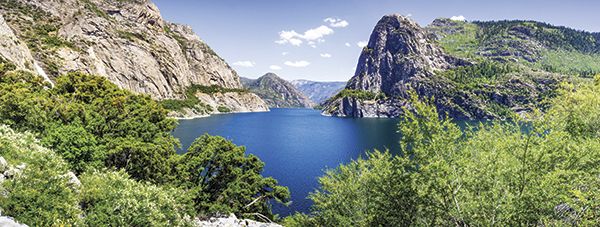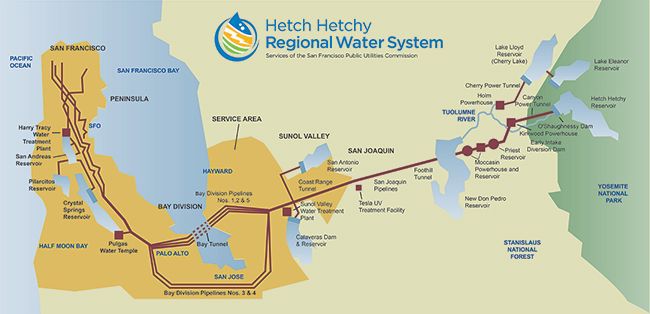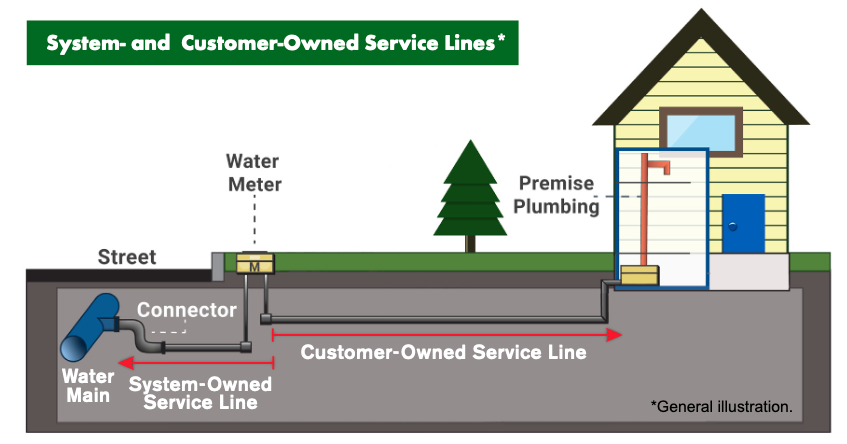PHWD Water Quality
Together with the SFRWS, the PHWD regularly collects and tests water samples from reservoirs and designated sampling locations throughout its system to ensure the water delivered to you meets all state and federal drinking water standards. In 2023, the SFRWS conducted more than 49,610 drinking water tests in the source, transmission, and distribution system. This is in addition to its extensive treatment process control monitoring performed by the certified operators and online instruments

As water travels over the surface of the land or through the ground, it dissolves naturally occurring minerals and, in some cases, radioactive material, and can pick up substances resulting from the presence of animals or human activity. Collectively, these are called contaminants. Therefore, drinking water, including bottled water, may reasonably be expected to contain at least small amounts of some contaminants. The presence of contaminants does not necessarily indicate that water poses a health risk. To ensure that tap water is safe to drink, the United States Environmental Protection Agency and the State Water Resources Control Board prescribe regulations that limit the amount of certain contaminants in water provided by public water systems. The United States Food and Drug Administration regulations and California law also establish limits for contaminants in bottled water that provide the same protection for public health.

Annual Water Quality Reports
Water quality results are published annually in the PHWD Consumer Confidence Reports (CCRs).
- 2023 Consumer Confidence Report (PDF)
- 2022 Consumer Confidence Report (PDF)
- 2021 Consumer Confidence Report (PDF)
- 2020 Consumer Confidence Report (PDF)
- 2019 Consumer Confidence Report (Available Soon)
- 2018 Consumer Confidence Report (PDF)
- 2017 Consumer Confidence Report (PDF)
- 2016 Consumer Confidence Report (PDF)
- 2015 Consumer Confidence Report (PDF)
Our Drinking Water Sources and Treatment
The SFRWS’s drinking water supply consists of surface water and groundwater that are well protected and carefully managed. These sources are diverse in both origin and location with the surface water stored in reservoirs located in the Sierra Nevada, Alameda County, and San Mateo County, as well as groundwater stored in a deep aquifer located in the northern part of San Mateo County. Maintaining this variety of sources is an important component of our near- and long-term water supply management strategy. A diverse mix of sources protects us from potential disruptions due to emergencies or natural disasters, provides resiliency during periods of drought, and helps us ensure a long-term, sustainable water supply as we address issues such as climate uncertainty, regulatory changes, and population growth.
To meet drinking water standards for consumption, all surface water sources, including the upcountry non-Hetch Hetchy sources, undergo treatment before it is delivered to our customers. While the water from Hetch Hetchy Reservoir is exempt from state and federal filtration requirements, it does receive the following treatment before being delivered for your consumption: disinfection using ultraviolet light and chlorine, pH adjustment for optimum corrosion control, fluoridation for dental health protection, and chloramination for maintaining disinfectant residual and minimizing the formation of regulated disinfection byproducts. Water from local Bay Area reservoirs in Alameda County and upcountry non-Hetch Hetchy sources is delivered to Sunol Valley Water Treatment Plant; whereas water from local reservoirs in San Mateo County is delivered to Harry Tracy Water Treatment Plant. Water treatment at these plants consists of filtration, disinfection, fluoridation, optimum corrosion control, and taste and odor removal. In 2023, neither upcountry non-Hetch Hetchy sources nor groundwater was used by the SFRWS.

Taste, Odor, or Discolored Water Issue?
Opening a faucet or two in your home or business, or an outside spigot, to let the water run for a couple of minutes should resolve it. Remember to capture the water in a bucket to use for watering indoor plants or outdoor landscaping!
Depending upon the water turnover in the mainline serving your connection, or seasonal fluctuations in water treatment by San Francisco Water, a temporary water quality issue could be quickly resolved with a mini-flushing of your service line.
You can now use PHWD's Online Water Quality Self-Diagnosis Tool to help determine possible causes and solutions of typical water quality issues experienced in a home. If the problem persists, please contact us at 650-948-1217 or online here.
Protection of Watersheds
The SFRWS conducts watershed sanitary surveys for its Hetch Hetchy source annually and every five years for its local water sources and upcountry non-Hetch Hetchy sources. The latest sanitary surveys for the non-Hetch Hetchy watershed were completed in 2021 for the period of 2016-2020. All these surveys together with our stringent watershed protection management activities were completed with support from partner agencies including the National Park Service and the United States Forest Service. The purposes of these annual and quinquennial surveys are to evaluate the sanitary conditions and water quality of the watersheds and to review the results of watershed management activities conducted in the preceding years. Wildfire, wildlife, livestock, and human activities continue to be the potential contamination sources. You may contact the San Francisco District office of the State Water Resources Control Board’s Division of Drinking Water at 510-620-3474 for more information.

Special Health Needs

Some people may be more vulnerable to contaminants in drinking water than the general population. Immunocompromised persons, such as those with cancer undergoing chemotherapy, persons who have undergone organ transplants, people with Human Immunodeficiency Virus/ Acquired Immunodeficiency Syndrome or other immune system disorders, and some elderly people and infants, can be particularly at risk from infections. These people should seek advice about drinking water from their healthcare providers.
Cryptosporidium is a parasitic microbe found in most surface water. The SFRWS regularly tests for this waterborne pathogen and found it at very low levels in source water and treated water in 2023. However, current test methods approved by the United States Environmental Protection Agency do not distinguish between dead organisms and those capable of causing disease. Ingestion of Cryptosporidium may produce symptoms of nausea, abdominal cramps, diarrhea, and associated headaches. Cryptosporidium must be ingested to cause disease, and it may be spread through means other than drinking water.
The United States Environmental Protection Agency and the Centers for Disease Control and Prevention guidelines on appropriate means to lessen the risk of infection by Cryptosporidium and other microbial contaminants are available from the United States Environmental Protection Agency’s Safe Drinking Water Hotline at 800-426-4791 or at www.epa.gov/safewater
Boron Detection Above Notification Level in Source Water
In 2023, boron was detected at a level of 1.7 ppm (parts per million) in the raw water stored in Pond F3 East, one of the San Francisco Regional Water System’s approved sources in the Alameda Watershed. Similar levels were also previously detected in the same pond. Although the detected value was above the California Notification Level (NL) of 1 ppm, the water was typically delivered to San Antonio Reservoir where it was substantially diluted to below the NL before treatment at the Sunol Valley Water Treatment Plant. Boron is an element in nature and is typically released into air and water when soils and rocks weather naturally.
No PFAS Detected
Per- and poly-fluoroalkyl substances (PFAS) comprise a group of man-made, persistent chemicals that have been used in the industry and consumer products since the 1940s. We did not detect PFAS in our water. To learn more, visit www.epa.gov/pfas
Fluoridation and Dental Fluorosis
Mandated by State law, water fluoridation is a widely accepted practice proven safe and effective for preventing and controlling tooth decay. Our fluoride target level in the water is 0.7 milligram per liter (mg/L, or part per million, ppm), consistent with the May 2015 State regulatory guidance on optimal fluoride level. Infants fed formula mixed with water containing fluoride at this level may still have a chance of developing tiny white lines or streaks in their teeth. These marks are referred to as mild to very mild fluorosis, and are often only visible under a microscope. Even in cases where the marks are visible, they do not pose any health risk. The Centers of Disease Control (CDC) considers it safe to use optimally fluoridated water for preparing infant formula. To lessen this chance of dental fluorosis, you may choose to use low-fluoride bottled water to prepare infant formula. Nevertheless, children may still develop dental fluorosis due to fluoride intake from other sources such as food, tooth paste and dental products.
Contact your healthcare provider or the SWRCB if you have concerns about dental fluorosis. For additional information about fluoridation or oral health, visit the SWRCB website www.waterboards.ca.gov or the CDC website www.cdc.gov/fluoridation
Lead and Drinking Water
Exposure to lead, if present, can cause serious health effects in all age groups, especially for pregnant women and young children. Infants and children who drink water containing lead could have decreases in IQ and attention span and increases in learning and behavior problems. The children of women who are exposed to lead before or during pregnancy can have increased risk of these adverse health effects. Adults can have increased risks of heart disease, high blood pressure, kidney, or nervous system problems.
Lead in drinking water is primarily from materials and components associated with service lines and home plumbing. There are no known lead service lines in our water distribution system. We are responsible for providing high quality drinking water and removing lead pipes, but we cannot control the variety of materials used in plumbing components in your home. You share the responsibility for protecting yourself and your family from the lead in your home plumbing. You can take responsibility by identifying and removing lead materials within your home plumbing and taking steps to reduce your family’s risk. Before drinking tap water, flush your pipes for several minutes by running your tap, taking a shower, doing laundry or a load of dishes. You can also use a filter certified by an American National Standards Institute accredited certifier to remove lead from drinking water. If you are concerned about lead in your water and may wish to have your water tested, call EPA’s Safe Drinking Water Regional Offices at (415) 947-4406 or go to www.epa.gov/lead for a lead test. Information about lead in drinking water, testing methods, and steps you can take to minimize exposure is available at USEPA website www.epa.gov/safewater/lead
As previously reported in 2018, PHWD completed an inventory of lead user service lines (LUSL) in our system and there are no known pipelines and connectors between water mains and meters made of lead.
Unregulated Contaminant Monitoring Rule
The SFRWS conducted four consecutive quarters of monitoring at designated locations approved by the United States Environmental Protection Agency in 2023, and all results have been non-detected.
Lead and Copper Inventory Compliance
PHWD completed the Lead and Copper Rule Revisions (LCRR) service line inventory on October 1, 2024. The EPA requires water systems to create and maintain a service line inventory of their materials. These results are accessible in the interactive tool below. If you have questions about the results of the LCRR service line inventory at your address, please contact the PHWD online here or call 650-948-1217.
Check Your LCRR Service Line Inventory Results
Enter your address below to see the results.
